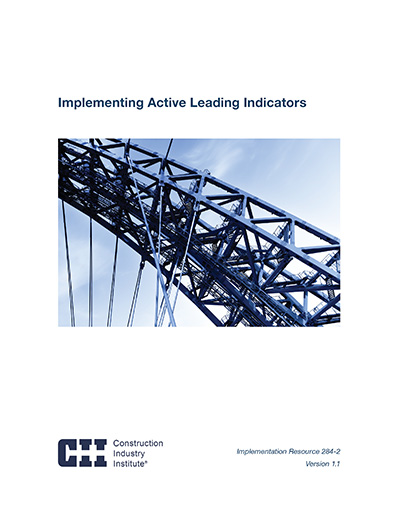
Implementing Active Leading Indicators, Version 1.1
This implementation resource will first define leading indicators, explaining the distinction between the active and passive types, and will then present the steps for establishing an active leading indicator program.
Leading indicators are measurements of processes, activities, and conditions that define performance and can predict future results. When performance is below expectations, these measurements provide guidance on where corrective interventions are needed. The term “metric” is commonly used interchangeably with “indicator.” But, in this approach, metrics are distinct from the two types of indicators assessed. A leading indicator is the result of the periodic measurement of specified performance. A lagging indicator is linked to the outcomes of past events and provides data on past performance. In the area of safety, lagging indicators include Experience Modification Rate (EMR), Total Recordable Incident Rate (TRIR), and Days Away, Restricted, or Transferred (DART). An indicator with a metric that prompts a proactive response relative to the process it measures is here defined as an “active leading indicator.”
An indicator can exist without a meaningful (actionable) metric. Consider the process of safety qualification. Organizations that utilize robust safety qualification processes have been found to experience lower project incident rates than those without such processes. (See CII Research Summary 190-1, The Owners’ Role in Construction Safety.) Thus, the use of a safety qualification process is an indicator of the expected safety performance. While safety qualification processes serve as indicators, there is not a clear metric associated with them, other than their presence or absence. Such indicators—ones without actionable metrics—are here defined as “passive leading indicators.” Another example of a passive leading indicator would be the decision to require all work crews to conduct pre-task planning meetings. Scores that might be devised to assess the quality of those pre-task planning meetings would be active leading indicators. In summary, passive leading indicators generally have “yes” or “no” as an answer to whether a practice or program is implemented, while active leading indicators generate a score or numeric value by which the practice or program can be assessed.
Many construction professionals look for a single indicator, or a reliable combination of indicators that will assure incident-free construction projects. However, because construction is a very dynamic process, performed by a transitory workforce within a constantly evolving environment, no single leading indicator is an accurate predictor of results for all projects. Thus, different leading indicators may be appropriate on different projects.
Additional observations from the RT-284 team from this research include (RT-284 Annual Conference Presentation, Implementation Session, Slide 45):
- Very few leading indicators are fully implemented by general industry (case study average TRIR was approx. 2.0).
- Projects where leading indicators were measured and fully implemented had an average TRIR of 0.19.
- Every firm can benefit from active safety leading indicators.
- A strong foundation of safety is a prerequisite to a successful leading indicator program.
- A champion must be identified and committed to success.
- The next step in research into active safety indicators is to carefully select a few of them, implement them on a project, and measure the results.
This resource presents the 9 Steps for providing an active leading indicator program. Leading indicators are policies and programs that are put in place before injuries occur to improve overall safety performance.


